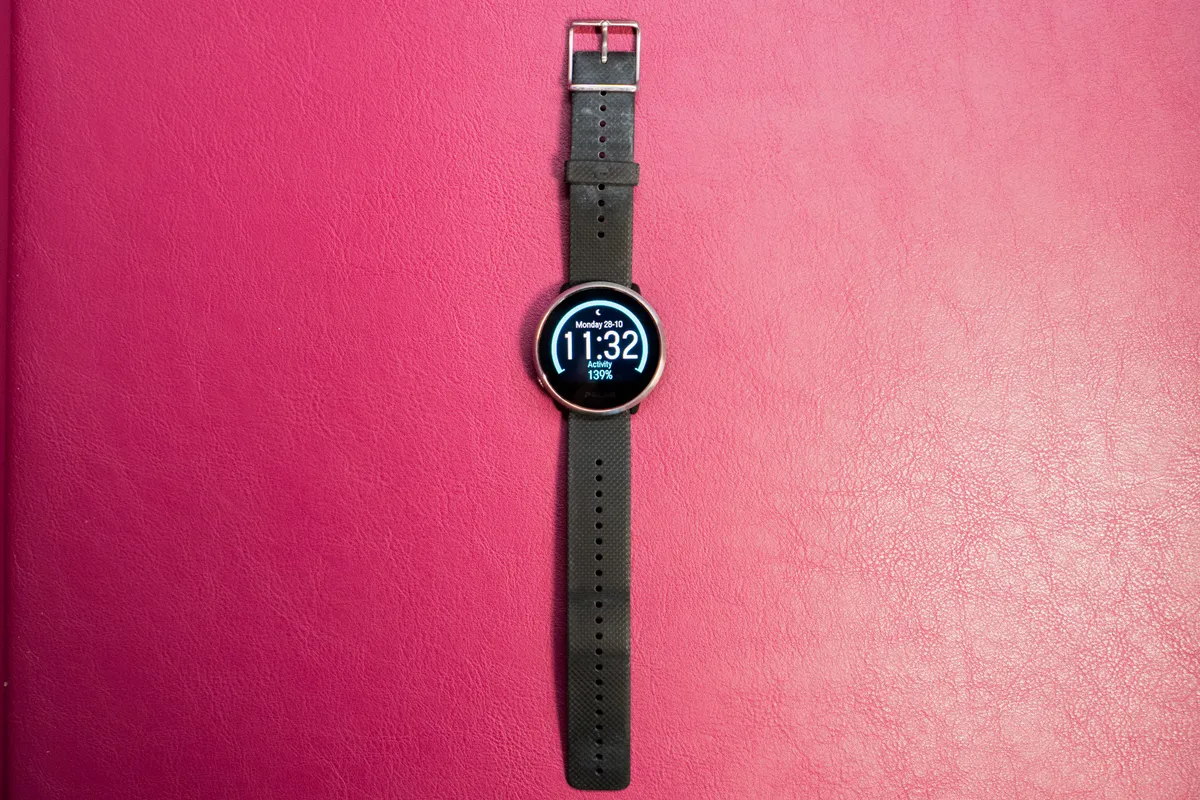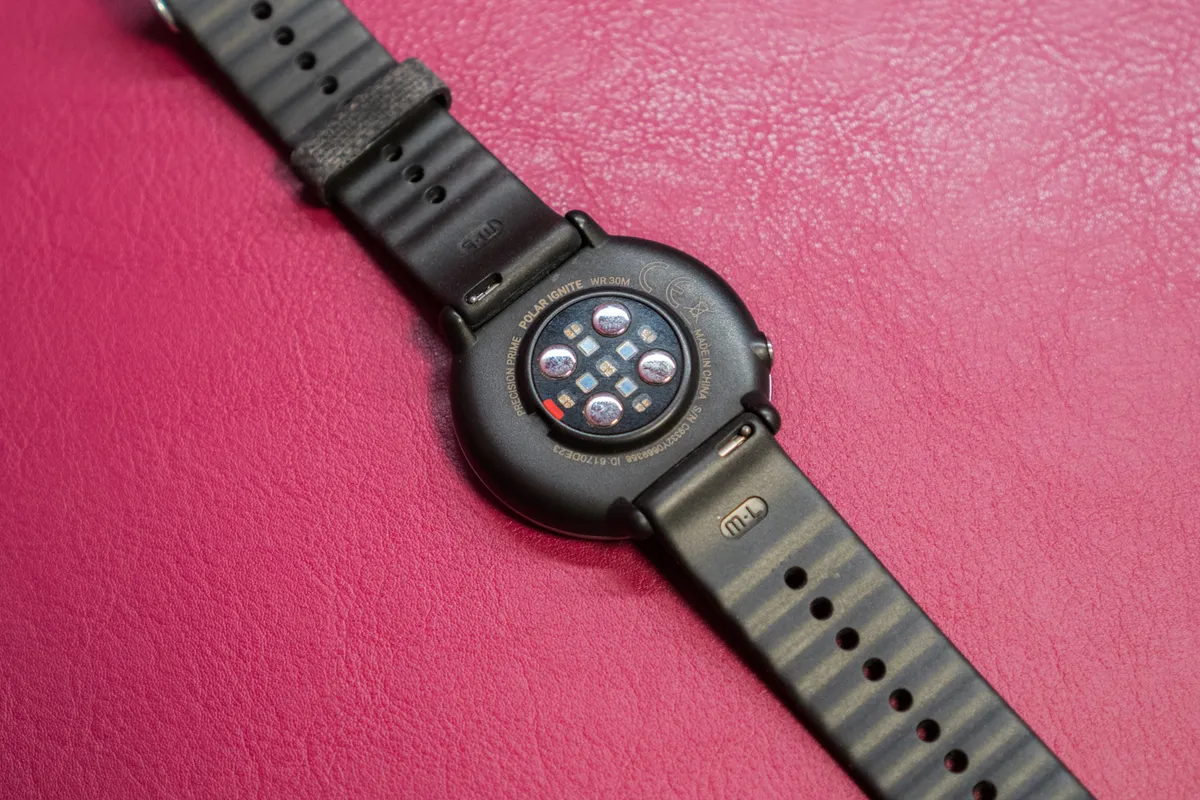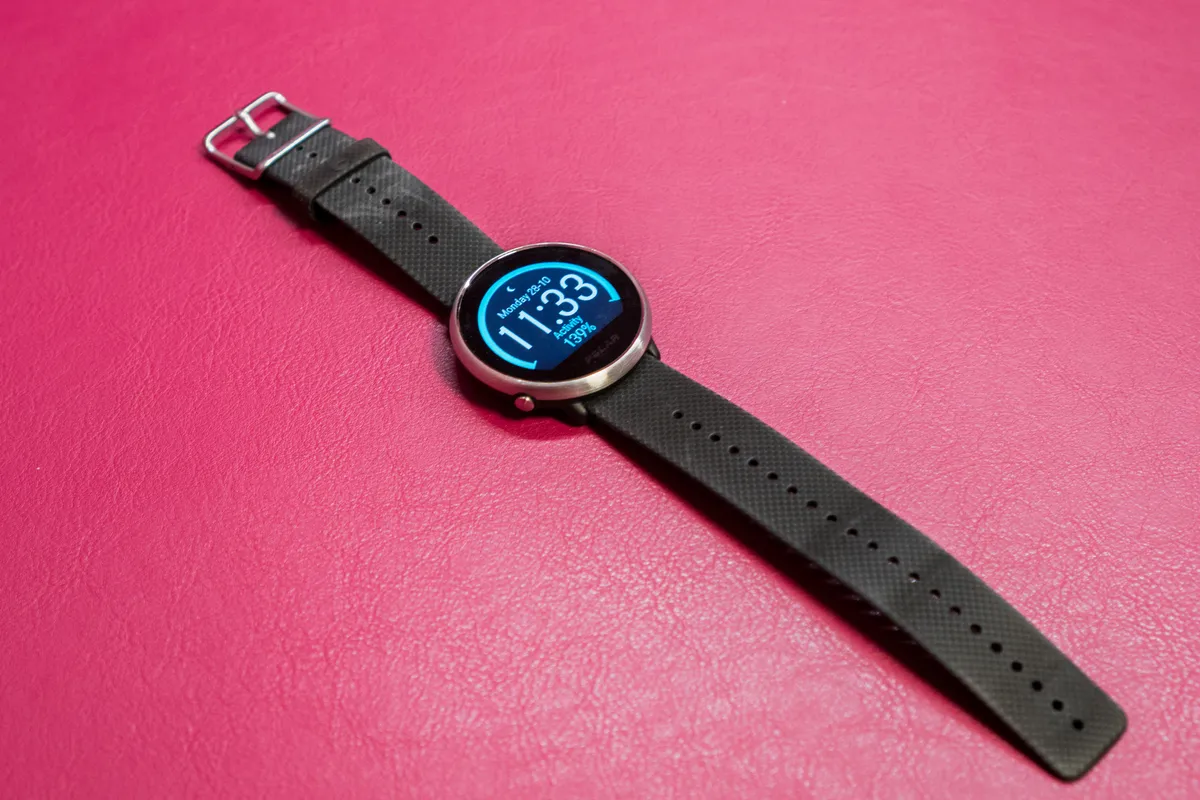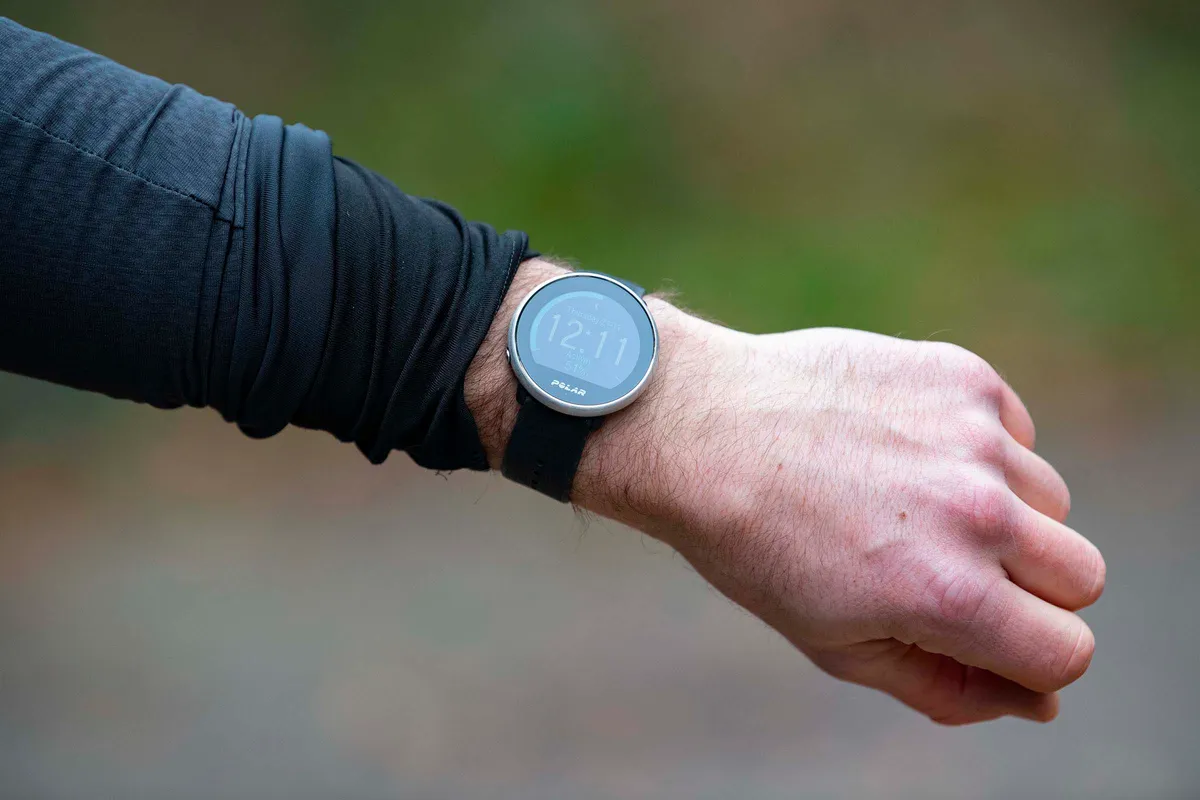Polar isn’t as well-known as Garmin but does offer an impressively wide range of products from bike-specific GPS computers to multi-sport GPS watches and running-specific devices, and I've been testing its Ignite GPS fitness watch that's designed for cycling, running and other outdoor workouts.
- Is the Garmin Venu OLED GPS smartwatch an Apple Watch killer? Plus updated Vivoactive range
- Garmin Edge 830 GPS computer review
The Ignite bridges the gap between bar-mounted GPS and fully-blown, hyper-expensive fitness smartwatches, but how does it fare being used as a replacement for the dedicated bike computer? I strapped one to my wrist to find out.
Specification

A clear, high-contrast 240 x 204 pixel resolution colour touchscreen (IPS TFT) dominates the watch's circular face. There’s a small physical button on the left-hand side of its bezel, and both the button and bezel are made from steel.
The watch's body is constructed using a glass fibre reinforced polymer – or plastic for the layperson.
On the back, there's a heart rate tracker and connectors that function as a charging port. The black wristband on the model I tested is made from TPU plastic and has a stainless-steel buckle.
The watch has an integrated GPS and GLONASS antenna and Bluetooth connectivity that’s used to connect compatible Bluetooth heart rate sensors and sync the watch with a phone that’s running Polar Flow – Polar’s mobile-based fitness app.
The 165 mAh lithium polymer battery lasts a claimed five days in watch mode with continuous heart rate monitoring and up to 17 hours with GPS enabled while recording an activity.
The watch doesn’t require a computer or phone with an internet connection for set up, but it is recommended to be able to access all of the watch's features.
To top things off, the Ignite has a WR30 water resistance rating, which means you can use it for swimming, wear it in the shower or bath, and in disgusting weather conditions.
Features and details

The Ignite’s hardware is certainly impressive, but it will be the software that’s most important for any discerning fitness addict.
It calculates how many calories you burn during a day based on your weight, height, age, gender and other factors. This is measured using the in-built heart rate monitor and is activated for the entire time you’re wearing it.
It measures your sleep patterns, once again using the in-built heart rate monitor that detects which sleep stage your body is in and how well you’re resting. The watch's software then calculates a sleep recharge score so you can evaluate how well you slept and how ready your body is for exercise.
There's an activity load guide with a percentage score that incorporates general daily movement with recorded activities to show you how active you’ve been and how much more movement you need to do to reach your goal.
There's also an in-built daily training guide that can create workouts, taking into consideration your current activity load, recovery and training history. You’ll get feedback on the benefits of your training session, explaining what you’ve achieved too.
An in-built programme can test your fitness and there are breathing exercises to help you relax, swimming metrics, a running index that helps to estimate your VO2 max and a running programme that gives you advice on how to train.
The Ignite supports up to 100 different sports, so if you’re into Nordic skiing, mountain biking and roller skating you should be able to find an activity type to suit you.
Performance
How does the Ignite perform as a GPS and fitness smartwatch, then? I’ve been wearing it for a good few months to find out.

Tracker performance
The thing that surprised me the most about the Ignite watch was how useful I found the non-bike-specific features, such as the nightly recharge and sleep stages data, and the activity guide percentage.
The continuous heart rate monitoring that supplies the information for these features to work is displayed as useful, easy to digest bits of data that helped shape my day’s worth of activity.
The sleep function was particularly useful and provided answers to questions I regularly ask myself: “Why do I feel so tired?” “Did I sleep well?” etc. Using this information meant I could make informed decisions about whether I should or even need to go riding.
Daily activity monitoring is another interesting metric and really highlighted how sedentary office-based work and car or train based travel is. On the flip side, I found it impressive how much of a day’s activity percentage can be gobbled up by a simple commute to work on the bike.
A quick note here, my commute is a round trip of just under 60km, so it comes as no surprise that it ate quite hungrily into my activity percentage!
Likewise, after spending a day out on the bike doing a solid ride I noticed my daily activity percentage would be in excess of 300 per cent. I used this scale to indicate when I really should rest or, if I'd had successive sedentary days, go out and send it.
The watch did struggle to correctly identify when I was sitting in a moving vehicle as ‘resting’ time and often classed my car journeys as low intensity activity – which is defined as standing work or light household chores. This was a tad frustrating at worst.
All of these statistics need to be taken with a pinch of salt, though, because there is going to be a margin of error. They are great to use as a starting point from which you can plan your current and future activities.
The battery lasts as long as Polar claims and I managed to eke out five days of power from the watch as long as I wasn't using the GPS. The heart rate monitor function, when the watch is just being worn casually not for activity recording, appeared to record accurately too.
GPS activity recording performance
The Ignite's recording of GPS-based activities, such as cycling, impressed me. GPS accuracy was as good as dedicated bar-mounted GPS devices, and only suffered from the GPS track wondering in particularly dense woods.
GPS signal takes around 2 minutes to be acquired, as long as you’re in a fairly open location. Indoors or in deep woods it did take longer, but once the watch had signal it rarely dropped out and was quick to get signal again if it did lose it.
When I was recording a particularly vigorous activity, the in-built heart rate monitor did sometimes provide slightly spurious information and was very dependent on how tight the watch was worn, whether cuffs were interfering with the heart rate monitor sensors or how much it was moving around on my wrist.
It does record some continuous heart rate information, but I found this data to be at odds with data from a chest-based monitor. Luckily, the watch is compatible with Bluetooth HR straps and anyone who’s serious enough about accurate HR information should either already own or purchase a strap to go with the watch.
The accuracy of the HR data didn’t come as a surprise because this type of heart rate monitor is known for its lack of accuracy. It’s hard to mark the watch down for this, especially because the option to pair it with a heart rate strap is there.
When used as an activity tracker and GPS recording device, I found the battery lasted between two and four days depending on how long the activities I recorded were.
Comfort
The watch was comfortable to wear even when my arms and muscles were pumped up during long descents or particularly rough sections on the bike.
This surprised me because I've never been a fan of wearing a watch out on the bike – which is a preference the Ignite has changed.
I now only take the watch off to charge, otherwise it remains on my wrist 24/7, even when I’m using a bar-mounted GPS to record activities.
The rubberised strap didn’t cause any irritation, redness or itching on my wrist, which some rubber watch straps are prone to producing, especially when they’re covered in dried-on sweat.
The low weight (36g with strap) meant that the watch was virtually imperceptible on my wrist and once it was located in the correct position I wasn’t constantly readjusting its fit.
User interface and ease of use
The touchscreen is easy to use and the way the watch functions is so intuitive I didn’t feel like I needed to consult the manual to operate its functions proficiently. The single button’s multiple uses are simply defined and it’s tricky to mistake one function for another.
The user interface is aesthetically attractive and clear to understand, and I've had no issues with being lost in menus or selecting options erroneously.
The touchscreen can be operated by water droplets, however. The solution to this problem is to not use the watch when it is submerged in water or if it’s raining heavily. Locking the display to prevent it from waking by touching the screen is also easy and solves this problem.
Accompanying software: Polar Flow
While the watch functions without any additional software, you’re going to get a much better experience if you download Polar Flow to your phone or sync the watch with a computer to access the web-based version of the same programme.
Polar Flow, especially on iOS (I tested it on Apple hardware), is intuitive and easy to use with simple, clear and informative displays of the data the watch records. Syncing with the app is also a breeze as long as your phone is compatible with the watch's minimum requirements.
More in-depth data is available on the web-based version of Polar Flow, but the phone app is beyond adequate for even the geekiest of data nerds.
The computer-based Flow Sync app – that’s used as a proxy for uploading your data to Polar Flow – isn’t great and can be buggy if you’re being impatient. Normally, closing and re-opening the programme and waiting for it to do its thing solved most issues.
The bottom line

Can the Ignite replace the dedicated bike GPS for the fitness or cycling enthusiast? In short, no it can’t. It’s not compatible with cadence, speed and power sensors and doesn’t display as much information on-screen as a dedicated computer does.
But, for the more casual user with a heart rate strap or for someone who’s looking to use it in conjunction with a GPS cycling computer, it certainly ticks a lot of boxes. It's a fraction of the cost of halo models and has earned itself a place in our best cycling watch list alongside many of them.
Yes, sometimes the heart rate data can be questionable when you’re recording an activity, but generally speaking the device provided reliable, data-rich and easy to access information about the levels of activity, stress and sleep I was subjecting my body to.
Even for the less dogmatic exerciser, access to clear information is invaluable and it can record your rides to boot.
Product
| Brand | Polar |
| Price | A$349.00, €199.95, £174.50, $229.95 |
| Weight | 36g |
| br_whatWeTested | Polar Ignite GPS fitness watch black-silver medium/large strap |
Features
| Strava live segments | no |
| Rechargeable battery | yes |
| Turn by turn navigation | no |
| Smartphone notifications | yes |
| Screen type | colour |
| Screen type | touchscreen |
| Connectivity | bluetooth |
| Features | GPS & GLONASS Water resistant 30m Continuous heart rate Training programmes Sleep tracking Fitness tracking |
| Dimensions | 43X42X8.5mm |
| Battery life | 17-hours with GPS enabled, 5 days in watch mode with continuous HR tracking |
| Water resistance | WR30 |
| Screen dimensions | 240X204 |
| Display resolution | 240X204 |
| Sensor compatibility | BLE heart rate |

